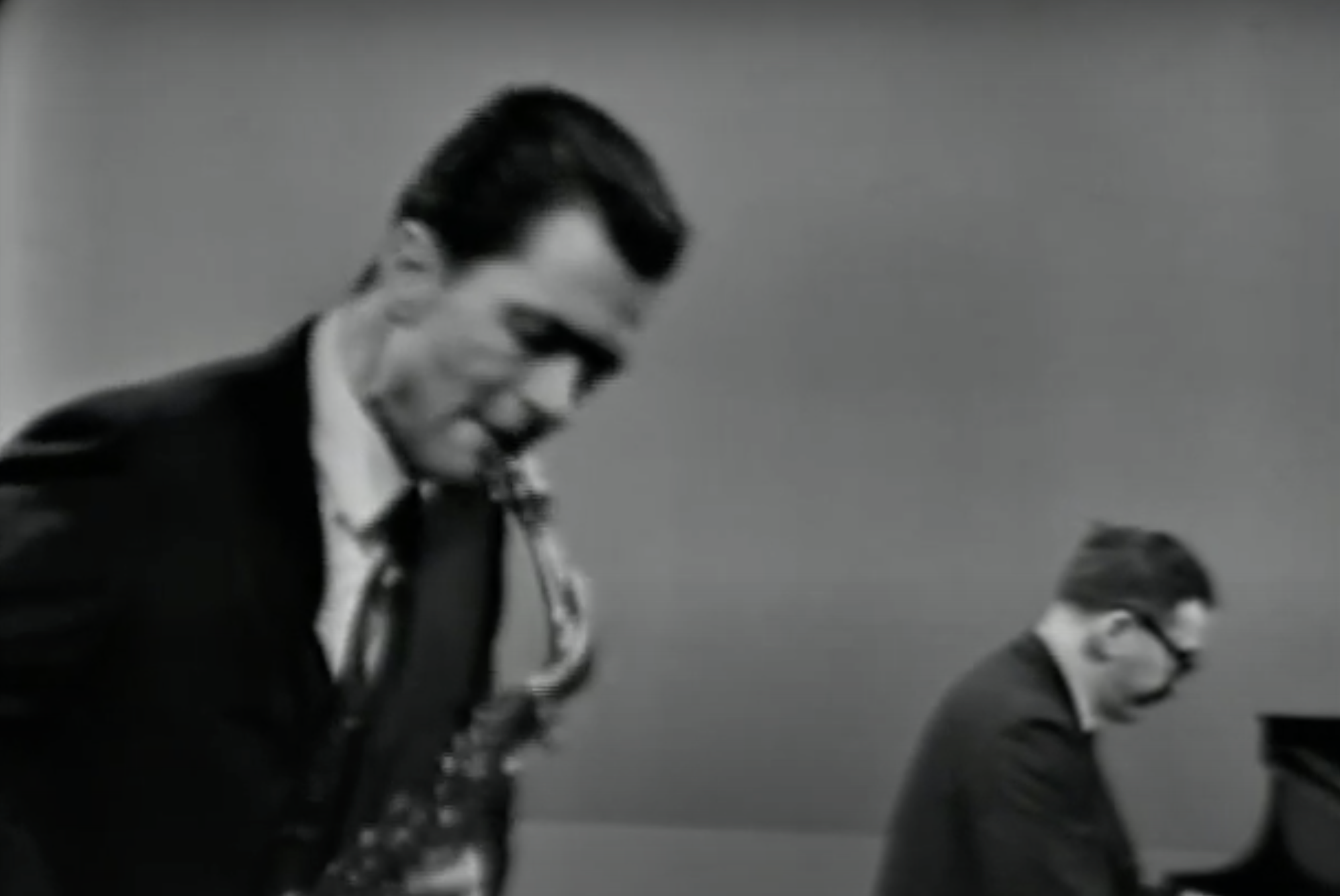Blue Rainbow Art
read at 2017 ARTISTS' PICKS (textura)

Art Pepper and Frank Strazzeri
I'm utterly astonished by the greatness of alto saxophonist Art Pepper. To begin with, he has, arguably, the most perfect instrumental sound ever spawned by the musical art form known as jazz. Truth be told, jazz alto saxophone is likely the musical subject I am most well-versed in. Of the alto artists who have engaged me most, Charlie Parker came first, followed primarily by Lee Konitz and Jackie McLean, and also Paul Desmond, Cannonball Adderley, Ornette Coleman, Sonny Stitt and Phil Woods. The instrument itself is jazz's most dynamic timbre, floating in-between dimensions, refusing to be tied down. At once sharp and dangerous as a rapier while simultaneously mystically dreamy and vibrant foreshadowing rainbow cloudbursts. Right away, I would argue that Pepper's emotional impact is the closest to Parker's exquisite flavour, while remaining distinctive, than anyone else who followed. This remarkable quality results from having internalized Parker's and Lester Young's rasas (expressive essence), rhythmic resonances, and phrasing in soul-searing fashion, as if fortifying himself for the ultimate musical journey within; a jewel of the lotus, with the jewel representing the individuality of the utterer and the lotus the universe. (When asked to give a definition while an undergraduate, I wrote: "Quality is epiphany illuminated by a jewel of the lotus.") As indicated, in terms of woodwind influences upon Pepper's art, Charlie Parker and Lester Young are equally titanic catalysts, along with Benny Goodman, Artie Shaw and Stan Getz. Amazingly, Art demonstrates that he would have been equally brilliant and substantive on tenor saxophone and clarinet if he'd chosen to focus on either of those horns rather than alto. If that sounds hard to believe, perhaps you'll agree with me after checking out the tenor saxophone and clarinet recordings left to us. Additionally, I perceive more of a trumpet influence in Art's playing than any other altoist. It would appear to have resulted from his intimate exposure to Benny Carter, who, most unusually, doubled on alto saxophone and trumpet, and whose band Pepper played in at a formative age. (To a greater extent, in my essay Transcendental Consolidation, the seminal influence of trombonist Jack Teagarden upon Getz's tenor saxophone style is explored.) It might also be argued that Pepper's relatively unusual use of a Martin alto saxophone early in his career elicited slightly more of a brass (than is common) as opposed to woodwind slant, the saxophone having been conceived by Adolph Sax as combining the power of the brass with the flexibility of the woodwinds. Last, but perhaps not least, I discern an enthusiasm for trumpeter Fats Navarro's cathartic explorations in Pepper's playing. How incredibly horrific that something like one-third of Art's artistic life was spent in prison. It's terrible to contemplate how some of America's greatest musicians, Gene Ammons too, were severely compromised by the debacle of targeting and punishing jazz musicians rather than assisting them related to illegal narcotics. In the case of Pepper, these incarcerations make it especially difficult to comprehend the totality of his musical output because his playing seems to change significantly every time he want away and came back. Bill Evans once said that feeling comes first in jazz, if not all music, and the Pepper tracks that speak most deeply to myself, at these admittedly early stages of my experience with his body of music, are found among his later work, being “Blue Bossa,” composed by Kenny Dorham, and “Somewhere Over the Rainbow,” by Harold Arlen and Nip Harburg. In fact, Joe Henderson was the king of “Blue Bossa” for me until I heard Pepper's rendition from the Among Friends album. Moving swiftly like a horseman through a tattered battlefield filled with his comrades because to pause would be to lose all, Pepper's alto glints and shimmers with the fires of passionate fervor steeped in survival. His phrase at 1:39, reminiscent of Laura Nyro, is a stunning and shattering glimpse into the human heart. All in all, this rendition epitomizes Steve Job's statement: "Simplicity is the ultimate in sophistication." The ballad performance I've selected, “Somewhere Over the Rainbow,” from the Ballads for Four album, is another colossal achievement. Pepper's instrumental palette of tone colors, dynamic graduations, intonational sublimations—even when they're ‘technically' off, they're expressively perfect—and registerial contrasts, all illuminating a rarified naked distillation of rasa, are enough to populate a new world - something us humans better start searching for!
Mention must be made of the magnificent bassist Bob Magnusson who spurs Pepper to such spectacular aesthetic heights along with Frank Butler on drums and Russ Freeman on piano for “Blue Bossa.” Similarly, special attention must be given to Cecil McBee on bass for “Somewhere Over the Rainbow,” along with Roy Haynes on drums and Stanley Cowell on piano. Fortunately, there are troves of musical treasures Art Pepper has left us in recordings both released and unreleased and still to be discovered, no doubt. Knowing that Art Pepper was, coincidentally, born in Los Angeles and made his adult home here, too, I'm especially glad during the holiday season to shine some light on his bewitching oeuvre, the importance of which will continue to rise. - Michael Robinson, December 2017, Los Angeles
© 2017 Michael Robinson All rights reserved
Michael Robinson is a Los Angeles-based composer, programmer, jazz pianist and musicologist. His 187 albums include 151 albums for meruvina and 36 albums of piano improvisations. Robinson has been a lecturer at UCLA, Bard College and California State University Long Beach and Dominguez Hills.
This writing originally appeared in textura, a Canadian music publication.
|